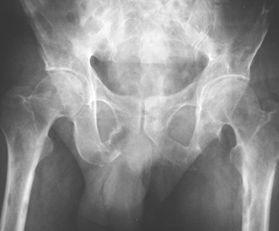
Osteoarthritis of the Hip
Osteoarthritis is a condition that affects joints including bone, cartilage, ligaments and muscles. Osteoarthritis can include inflammation of the tissue around the hip joint, damage to joint surface cartilage, bony spurs growing around the edge of the hip joint and/or deterioration of the ligaments and tendons that hold the joint together.
Osteoarthritis tends to be more common in people aged over 40 years or those who have had joint injuries. The condition may also be referred to as Osteoarthrosis.
The most common symptoms are hip pain and stiffness of the hip that usually gets worse with activity. You may feel stiffness as you are getting out of bed, or if you have been sitting for a long time. These symptoms may affect your ability to do normal daily activities. Other symptoms include clicking noises, grating or crunching sensations of bone rubbing against bone, pain when walking or a loss of movement in the hip joint. Symptoms can vary for each person.
While there are various stages of Osteoarthritis, it is generally a gradual condition. Pain may initially come and go, but the hip will be inflamed by activity. Hip pain can become more persistent as the condition progresses. Eventually, at the end stage of arthritis, the articular cartilage wears away completely and bone on bone contact occurs.
Early Stage
In the early stage of hip osteoarthritis, symptoms are typically mild and may not only be noticeable after physical activity. Patients often experience slight discomfort and stiffness, particularly in the morning or after periods of inactivity. These symptoms may be sporadic and manageable without significant intervention.
Moderate Stage
As osteoarthritis progresses, the symptoms become more pronounced. Patients may experience increased pain, even during rest, and a reduced range of motion in the affected hip. Activities like walking or climbing stairs can become challenging, and there may be occasional swelling around the joint.
Advanced Stage
In advanced hip osteoarthritis, the cartilage in the hip deteriorates significantly, leading to severe pain and a considerable limitation in mobility. Patients may struggle with daily activities, and conservative treatments might no longer provide relief. At this stage, more intensive treatments, including surgical options, are considered.
Generally osteoarthritis can be somewhat attributed to wear and tear, but often a direct cause cannot be identified. Some factors that may put you at more risk of developing Osteoarthritis in the hip are:
• being overweight
• a previous hip injury
• repeated lifting of heavy loads
• a family history of Osteoarthritis
• increasing age
• where the hip joints may not have formed correctly
- Age: The risk of developing osteoarthritis of the hip increases with age, particularly after 40.
- Joint Injuries: Previous injuries or trauma to the hip, such as fractures or dislocations, can increase the risk of osteoarthritis. Even if the injury heals, it can lead to changes in the joint structure, making it more susceptible to hip osteoarthritis later in life.
- Genetics: A family history of osteoarthritis can predispose people to the condition.
- Lifestyle Factors: Obesity places additional stress on the hip joints, accelerating the breakdown of cartilage. Physical inactivity can also contribute to the weakening of the muscles supporting the hip, while certain occupations that involve repetitive hip movements or heavy lifting can increase the risk of osteoarthritis.
Your GP will diagnose Osteoarthritis, by talking over your symptoms and conducting a physical examination. An X-ray may be required, to check for narrowing and changes in the shape of your hip joint. An X-ray that shows joint damage does not always mean you will have a lot of pain or problems. On the other hand your joint may be very painful despite X-rays being ‘normal’. Blood tests are generally only helpful to rule out other types of arthritis. In more complex cases, your GP may organise for you to have a MRI (Magnetic resonance imaging) to produce more detailed images of the hip bone and soft tissues, including cartilage.
Treatment for hip osteoarthritis depends on which joints are affected and the severity of the condition. Each treatment has its own benefits and risks and you may need to trial several treatments before finding the one that assists you.
In general terms, the best treatment plan usually includes:
• A weight loss program, if you are overweight
• A hip exercise program that is tailored to your condition and ability. Although exercise may be the last thing you feel like doing, activities such as gentle stretching, walking, swimming and biking can be helpful to relieve arthritis pain, stiffness, and swelling.
• Pain management, with osteoarthritis medication and education about how to best manage your pain
• A walking aid such as a walking stick or frame can take pressure off the hips and provide additional support to the joints. It can help you to maintain your stability and balance, reducing the risk of a fall.
If your symptoms are no longer controlled with other therapies, you may be referred to an Orthopaedic Hip Surgeon. Adelaide orthopaedic hip surgeon. Hip replacement surgery may be necessary when osteoarthritis severely affects the joint and conservative treatments no longer provide relief. The procedure involves replacing the damaged hip joint with a prosthetic implant, which can significantly reduce pain and restore mobility.
Recovery from hip surgery involves a period of rehabilitation to restore strength and mobility. Physical therapy plays a critical role in this process, helping patients regain function and adapt to their new joint. With proper rehabilitation, most patients can return to their daily activities with improved quality of life.
Engaging in regular, low-impact exercises like swimming, cycling, or walking can help maintain joint health and reduce stiffness. Strengthening the muscles around the hip joint is also crucial in providing better support and reducing the load on the joint.
A diet rich in omega-3 fatty acids (found in fish, like salmon and mackerel) and antioxidants (found in fruits and vegetables) can help reduce inflammation and support joint health. Maintaining a healthy weight is also essential to reduce stress on the hips.
For managing pain, over-the-counter medications can be effective. Additionally, hot/cold therapy can alleviate pain and reduce swelling. Patients may also explore other non-invasive treatments like physical therapy or acupuncture.
If left untreated, hip osteoarthritis can lead to several complications. Chronic pain can become debilitating, significantly impacting quality of life. The loss of mobility may increase the risk of falls and fractures, particularly in older adults. Moreover, prolonged inactivity can lead to muscle atrophy and further joint deterioration. Early treatment is essential to manage symptoms effectively and prevent or delay these complications.
Book an appointment with our orthopaedic specialists
Book an appointment











